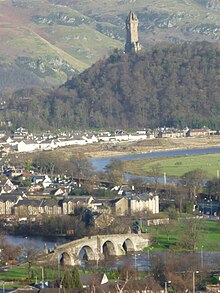Battle of Stirling Bridge
| Battle of Stirling Bridge | |||||||
|---|---|---|---|---|---|---|---|
| Part of the First War of Scottish Independence | |||||||
 Old Stirling Bridge with the Abbey Craig and Wallace Monument |
|||||||
|
|||||||
| Belligerents | |||||||
|
|
|
||||||
| Commanders and leaders | |||||||
|
William Wallace Andrew de Moray † |
|
||||||
| Strength | |||||||
|
5,300 to 6,300 men
|
9,000 men
|
||||||
| Casualties and losses | |||||||
| Unknown |
100 cavalry killed |
||||||
5,300 to 6,300 men
9,000 men
100 cavalry killed
The Battle of Stirling Bridge was a battle of the First War of Scottish Independence. On 11 September 1297, the forces of Andrew Moray and William Wallace defeated the combined English forces of John de Warenne, 6th Earl of Surrey, and Hugh de Cressingham near Stirling, on the River Forth.
The Earl of Surrey had won a victory over the aristocracy of Scotland at the Battle of Dunbar. However, by August 1297 Moray and Wallace controlled almost all of Scotland north of the Forth, except for Dundee. Surrey marched north with an army from Berwick to relieve Dundee. The town of Stirling was the key entry point to the north of Scotland.
The earl arrived at the narrow, wooden bridge over the River Forth near Stirling Castle and determined that he would be at a tactical disadvantage if he attempted take his main force across there. So he delayed crossing for several days to allow for negotiations, and to reconnoiter the area. On 10 September Warenne gave orders to cross the river the next day. At dawn the English and Welsh infantry started to cross only to be recalled due to the fact that Warenne had overslept.
The Scots arrived first and encamped on Abbey Craig which dominated the soft, flat ground north of the river. The English force of English, Welsh and Scots knights, bowmen and foot soldiers camped to the south of the river. Sir Richard Lundie, a Scots knight who joined the English after the Capitulation of Irvine, offered to outflank the enemy by leading a cavalry force over a ford two miles upstream, where sixty horsemen could cross at the same time. Hugh Cressingham, King Edward's treasurer in Scotland, persuaded the Earl to reject this advice and order a direct attack across the bridge.
...
Wikipedia
